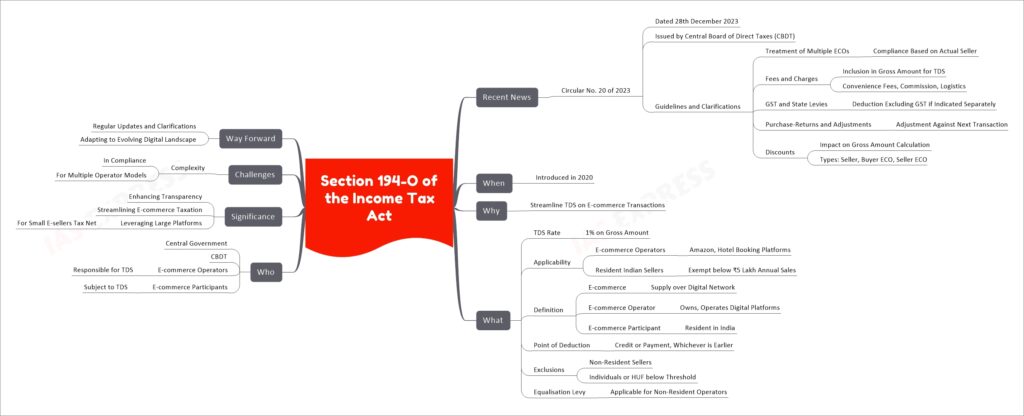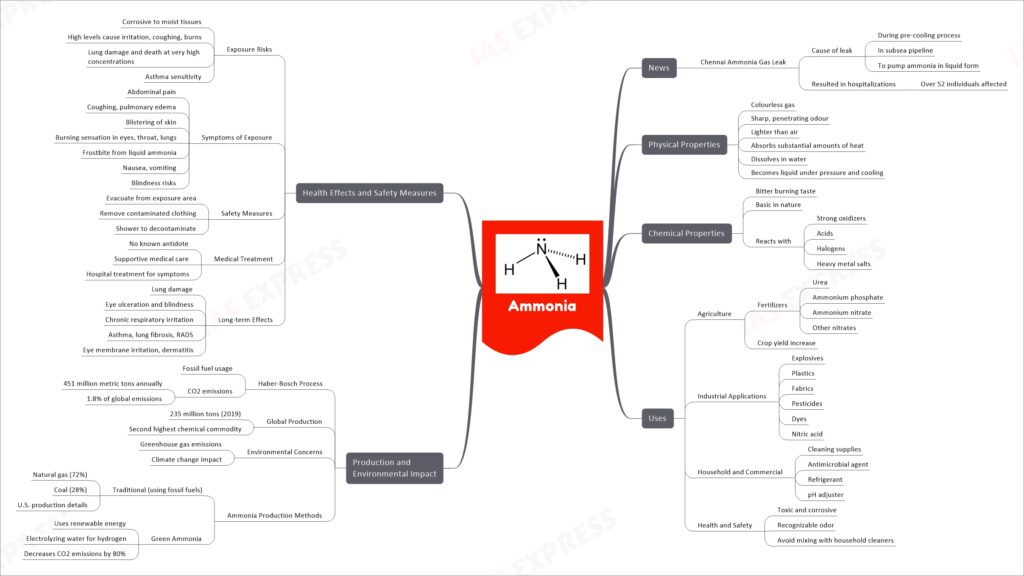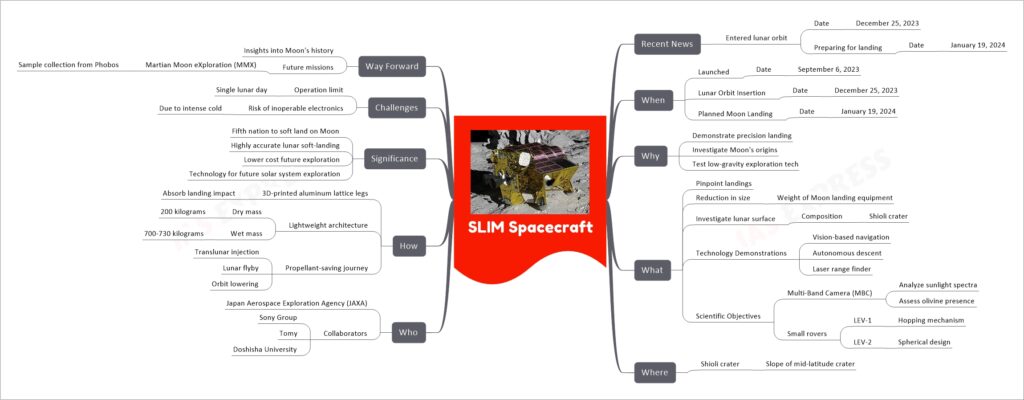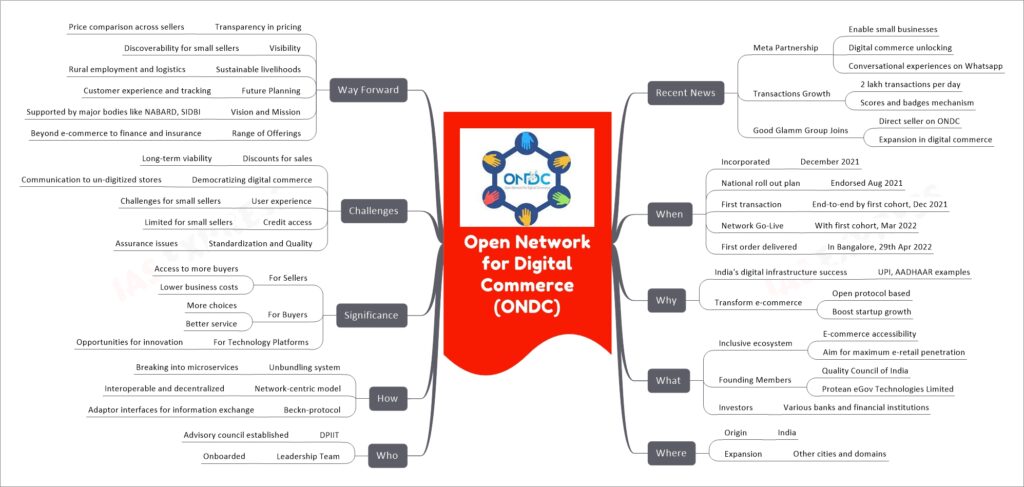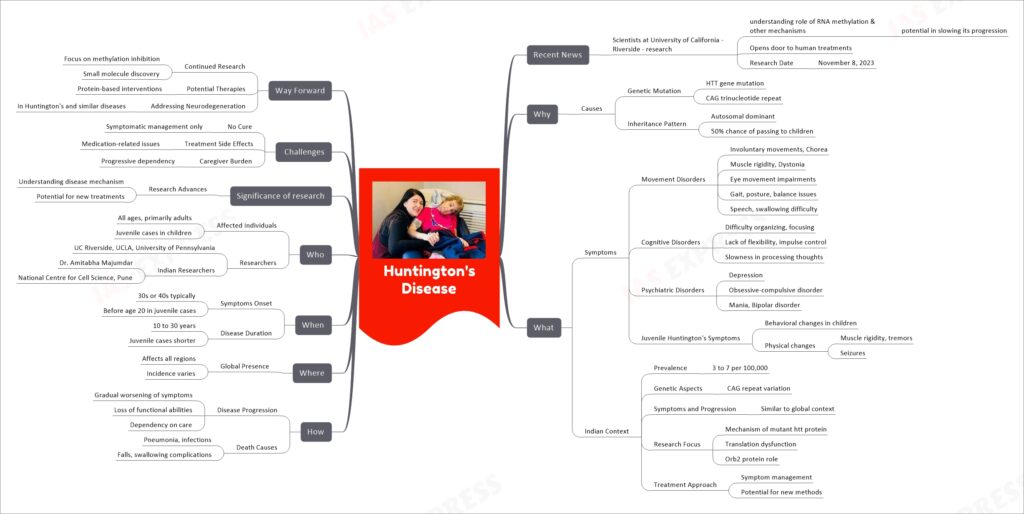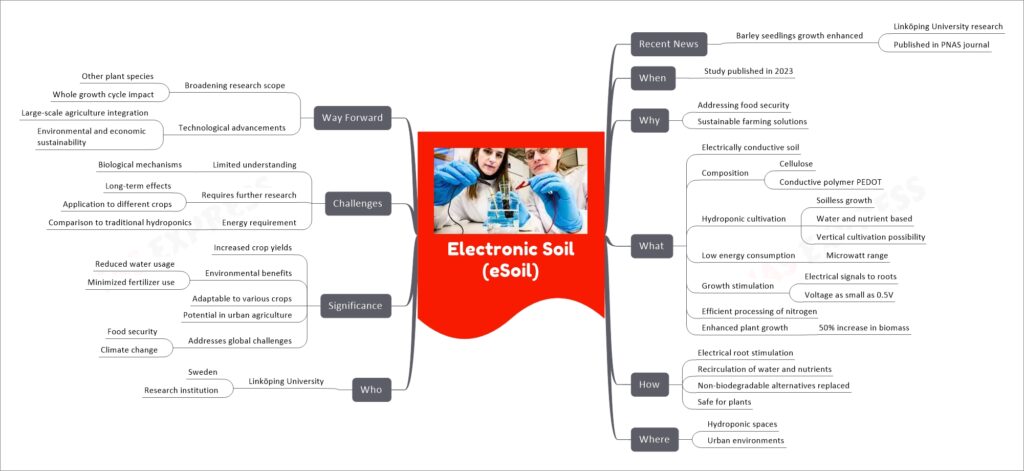[Newsbits] 29.12.2023: eSoil, ONDC, UPI Tap & Pay and more

This topic of “Ammonia Gas: Properties, Applications, Health Effects” is important from the perspective of the UPSC IAS Examination, which falls under General Studies Portion. Ammonia is a colorless gas, lighter than air, with a sharp odor, and it dissolves in water. It’s widely used in agriculture as a fertilizer to increase crop yield and in various industries to produce explosives, plastics, and other chemicals. The production of ammonia, mainly through the Haber-Bosch process using fossil fuels, contributes significantly to CO2 emissions and global warming. However, green ammonia production methods using renewable energy sources are emerging to reduce these environmental impacts. Exposure to ammonia can be harmful, causing skin and lung irritation, coughing, and even blindness at high concentrations. It’s essential to evacuate the exposed area and decontaminate by removing clothes and showering. There is no antidote for ammonia exposure, so medical treatment focuses on symptom management. Long-term exposure can lead to serious health conditions like lung damage, chronic respiratory irritation, and eye problems. Introduction: Ammonia is a versatile chemical compound with a wide range of applications across various industries. In recent news, a tragic incident in Chennai involving an ammonia gas leak has highlighted the importance of understanding the properties, uses, production methods, and safety measures associated with this compound. This article will delve into the world of ammonia, shedding light on its physical and chemical properties, uses, production processes, environmental impact, health effects, and safety precautions. Physical Properties of Ammonia: Chemical Properties of Ammonia: Uses of Ammonia: Production and Environmental Impact: Health Effects and Safety Measures: Conclusion: Ammonia’s significance in various industries and its potential hazards underscore the need for strict safety protocols and environmentally friendly production methods. Understanding its properties, uses, and health effects is essential for both professionals working with ammonia and the general public to prevent accidents and mitigate risks associated with this versatile compound. This topic of “SLIM Spacecraft: Japan’s Lunar Explorer” is important from the perspective of the UPSC IAS Examination, which falls under General Studies Portion. The SLIM Spacecraft, developed by Japan’s Aerospace Exploration Agency (JAXA), represents a significant step in lunar exploration. Launched in September 2023, SLIM’s primary goal is to achieve a highly accurate, pinpoint landing on the Moon’s surface, specifically targeting the Shioli crater. This innovative mission utilizes advanced technologies, such as vision-based navigation and lightweight architecture, to demonstrate precise lunar landing capabilities. With its successful landing, SLIM aims to set new standards in lunar exploration, potentially enabling more focused scientific investigations of specific lunar sites. The mission also aims to test technologies fundamental for future exploration within the solar system. The SLIM mission’s success could pave the way for more cost-effective and precise lunar missions, contributing significantly to our understanding of the Moon and beyond. In the realm of space exploration, the SLIM spacecraft has emerged as a remarkable project undertaken by the Japan Aerospace Exploration Agency (JAXA). This article delves into the intricacies of SLIM, its objectives, and significance. SLIM’s mission is driven by a triad of objectives: SLIM’s capabilities are extensive and include: SLIM’s mission destination is the Shioli crater, located on the slope of a mid-latitude lunar crater. The project is spearheaded by the Japan Aerospace Exploration Agency (JAXA) and collaborates with notable entities such as the Sony Group, Tomy, and Doshisha University. The spacecraft is equipped with several innovative features, including: The mission holds immense significance for space exploration, marking several milestones: However, the mission is not without its challenges, including operating within a single lunar day and the risk of electronics becoming inoperable due to extreme cold conditions. As SLIM continues its mission, it promises to provide insights into the Moon’s history. Additionally, its success will pave the way for future exploration missions, including the Martian Moon eXploration (MMX) project, which aims to collect samples from Phobos, one of Mars’ moons. This topic of “Open Network for Digital Commerce (ONDC): Pros & Cons” is important from the perspective of the UPSC IAS Examination, which falls under General Studies Portion. In simple terms, the Open Network for Digital Commerce (ONDC) is a digital project initiated by the Indian government to revolutionize e-commerce. It aims to create a more inclusive, open, and interoperable system for online commerce, similar to the transformative impact of UPI in digital payments. ONDC seeks to connect buyers, sellers, and service providers (like logistics and payments) through a common network, overcoming the limitations of current e-commerce platforms. This network-centric model enables greater participation of small sellers, enhances buyer choices, and fosters startup growth, addressing challenges like limited seller competitiveness and platform monopolization. However, it faces challenges such as scaling, standardizing quality, and improving user experience. The future of ONDC involves enhancing transparency, visibility for small sellers, sustainable livelihoods, and expanding its range of offerings. In the ever-evolving landscape of digital commerce, the Open Network for Digital Commerce (ONDC) stands out as a transformative force. This article delves into the intricacies of ONDC, its objectives, recent developments, and the road ahead. The recent collaboration between ONDC and Meta (formerly Facebook) is making waves in the digital commerce sphere, with the following key highlights: Transactions Growth: Powering Digital Commerce – ONDC has witnessed a significant surge in transactions, with a staggering 2 lakh transactions per day. This growth is fueled by innovative strategies such as the introduction of scores and badges, creating a competitive and rewarding environment. Good Glamm Group Joins ONDC – The inclusion of the Good Glamm Group as a direct seller on ONDC marks a pivotal moment in the platform’s expansion in the digital commerce landscape. This move promises to extend the reach of the platform and boost digital commerce in India. As ONDC continues its journey, several key areas will be in focus: In conclusion, ONDC is a catalyst for change in India’s digital commerce landscape. With its inclusive approach, innovative strategies, and collaborative efforts, ONDC is poised to drive the transformation of digital commerce, benefitting businesses, consumers, and the nation’s economy as a whole. This topic of “Huntington’s Disease: Causes, Symptoms, Treatment” is important from the perspective of the UPSC IAS Examination, which falls under General Studies Portion. Huntington’s disease is a rare, inherited disorder that causes the progressive breakdown of nerve cells in the brain, leading to movement, cognitive, and psychiatric disorders. Recent research has shown potential in slowing its progression through understanding the genetic mechanisms involved, particularly focusing on the role of RNA methylation. There’s no cure, but treatments focus on managing symptoms. The disease typically manifests in the 30s or 40s, with a juvenile form appearing earlier. It’s caused by a genetic mutation in the HTT gene, following an autosomal dominant inheritance pattern. In India, the disease affects 3 to 7 people per 100,000, with research focusing on mutant huntingtin protein and potential new treatments. In the world of medical science, a ray of hope has emerged for those battling Huntington’s Disease. Recent research conducted by scientists at the University of California – Riverside has shed light on promising developments in the understanding and potential treatment of this devastating neurodegenerative disorder. This article will explore the causes, symptoms, impact, and potential therapies for Huntington’s Disease, as well as the challenges it presents. Huntington’s Disease is a hereditary neurological disorder that causes progressive degeneration of nerve cells in the brain. It is characterized by a range of physical, cognitive, and psychiatric symptoms. Key aspects of the disease include: The disease manifests through a variety of symptoms, affecting different aspects of an individual’s life: Who is Affected by Huntington’s Disease? The Way Forward The recent breakthroughs in Huntington’s Disease research offer a glimmer of hope to those affected by this devastating condition. While challenges remain, the dedication of researchers and advancements in understanding the disease mechanism bring us closer to potential therapies. As we continue to explore the intricacies of Huntington’s Disease, we remain committed to finding ways to alleviate the suffering of those afflicted by this relentless neurodegenerative disorder. The Financial Intelligence Unit-India (FIU-IND) is a statutory body set up by the Government of India in 2004. It functions as the central national agency responsible for receiving, analyzing, and disseminating information about suspect financial transactions. FIU-IND is crucial in the fight against money laundering and terrorist financing. It operates under the directives of the Prevention of Money Laundering Act (PMLA) of 2002 and aligns with international standards set by bodies like the Financial Action Task Force (FATF). Recently, FIU-IND has been actively issuing compliance notices to offshore Virtual Digital Assets Service Providers for not adhering to the regulations of the PML Act. UPI Tap and Pay is a forthcoming feature introduced by the National Payments Corporation of India (NPCI), set to launch by the end of January 2024. This innovative payment method utilizes NFC (Near Field Communication) technology, allowing users to make transactions by tapping their smartphones against a receiver’s device. It is designed for transactions up to Rs 500, with a daily cap of Rs 4,000. Currently, this feature is available on BHIM and Paytm (for limited users), with other UPI apps also having the option to introduce it. While it aims to enhance user convenience and quicken the payment process, challenges like lack of trust, vulnerability to cyber-attacks, illiteracy, and limited internet penetration remain. Future prospects include more widespread adoption and possible expansion to other Asian countries. This topic of “Electronic Soil (eSoil)” is important from the perspective of the UPSC IAS Examination, which falls under General Studies Portion. In 2023, the world of agriculture witnessed a groundbreaking discovery that holds the promise of addressing crucial global challenges—food security and climate change. Researchers at Linköping University unveiled the remarkable potential of Electronic Soil (eSoil), an innovative concept with the potential to revolutionize farming as we know it. This article delves into the ‘what,’ ‘why,’ ‘how,’ ‘where,’ and ‘who’ of eSoil, examining its significance, challenges, and the way forward. eSoil is an electrifying breakthrough in agriculture. It involves the creation of electrically conductive soil, combining cellulose and conductive polymer PEDOT. This unique composition allows for hydroponic cultivation, a method that eliminates the need for traditional soil, relying instead on a water and nutrient-based system. Key components of eSoil include: eSoil emerges as a vital solution to address the pressing issues of food security and sustainability in agriculture. The motivations behind its development include: eSoil’s success is attributed to its unique methods: The adaptability of eSoil makes it suitable for various settings: Linköping University in Sweden, a renowned research institution, stands at the forefront of eSoil’s development. eSoil’s potential impact on agriculture and the environment is significant: While eSoil holds immense promise, it is not without challenges: Electronic Soil (eSoil) is not merely a scientific marvel but a beacon of hope for sustainable agriculture. Its ability to boost crop yields, conserve resources, and mitigate environmental impacts makes it a game-changer in the quest for a brighter, greener future in farming. With ongoing research and technological advancements, eSoil promises to revolutionize agriculture and contribute significantly to addressing global challenges. Section 194-O of the Income Tax Act, introduced in 2020, mandates e-commerce operators in India to deduct Tax Deduction at Source (TDS) at a rate of 1% on the gross amount of sales or services facilitated through their digital platforms. It covers resident Indian sellers and enterprises, termed e-commerce participants, and exempts those with annual sales below ₹5 lakh. The provision aims to streamline the taxation process for e-commerce transactions, enhancing transparency and compliance in the digital economy. The guidelines issued by the Central Board of Direct Taxes (CBDT) address various aspects of TDS deduction, including the treatment of fees, GST, purchase-returns, and discounts, ensuring clarity for multiple e-commerce operator models.Summary
Article
Summary
Article
When and Why SLIM Launched
What SLIM Does
Where and Who Is Involved
How SLIM Works
Significance and Challenges
Way Forward
Summary
Article
Recent News: ONDC and Meta Partnership
Inception and Rollout
The Why and What of ONDC
Why ONDC?
What is ONDC?
Where and Who
How ONDC Operates
Significance and Challenges
Significance of ONDC
Challenges Faced by ONDC
The Way Forward
Simplified Explanation
Comprehensive Explanation
Introduction
What is Huntington’s Disease?
Symptoms of Huntington’s Disease
Huntington’s Disease in the Indian Context
How Does Huntington’s Disease Progress?
Where and When Does Huntington’s Disease Occur?
Significance of Huntington’s Disease Research
Challenges and the Way Forward
Conclusion
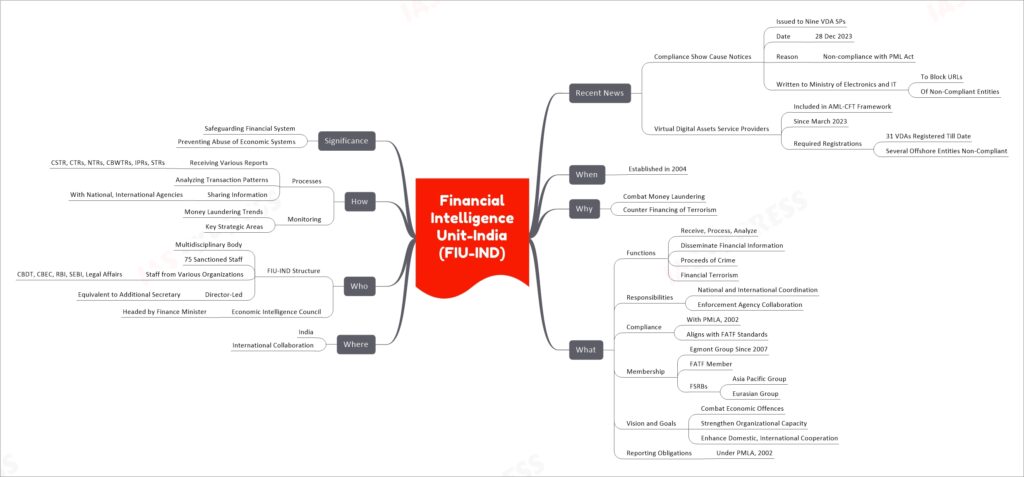
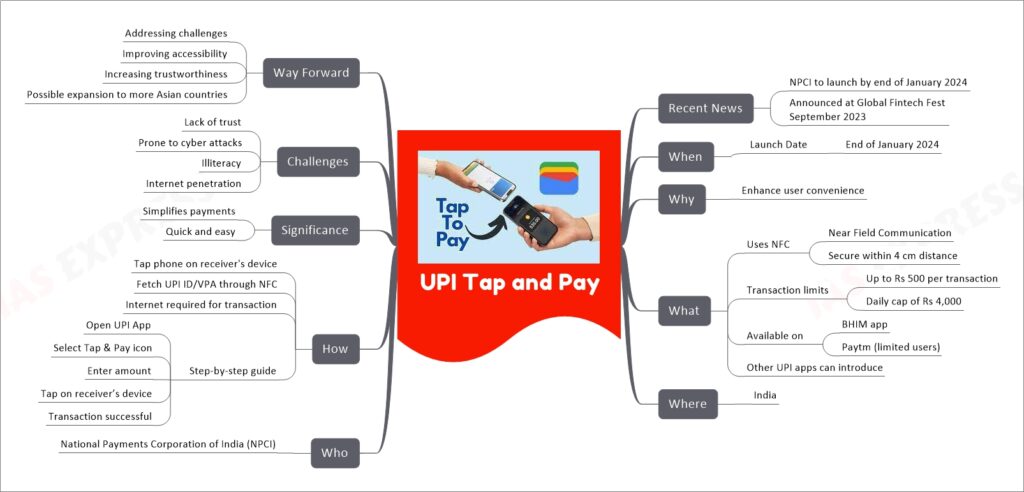
Introduction
What is eSoil?
Why eSoil?
How does eSoil work?
Where can eSoil be used?
Who is Behind eSoil?
Significance of eSoil
Challenges and the Way Forward
The way forward involves:
Conclusion
